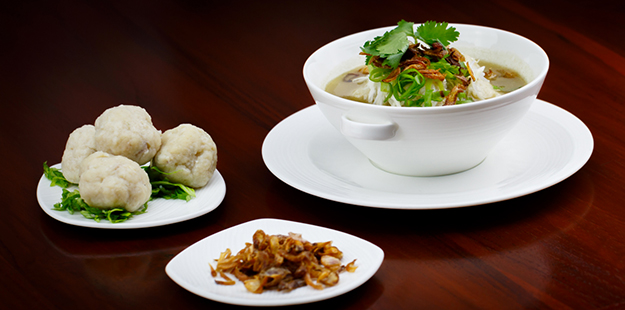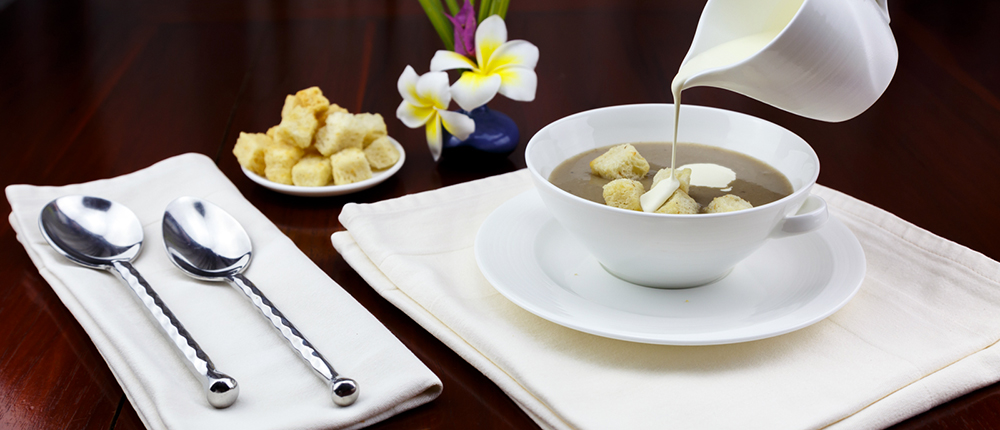A Taste of Wakatobi #2

Bakso, a savory meatball soup, in one of Indonesia’s most popular street foods. At Wakatobi, you’ll find it served in more elegant fashion. Photo by Marco Fierli
Bakso with chicken meatballs
It’s said that Bakso was one of President Obama’s favorite childhood foods. True or not, there’s no doubt that this savory meatball soup, which is also known as Baso without the K, is one of Indonesia’s most popular street foods. The meatballs are most often made of shredded or ground beef, with a binder of tapioca flour, but variations include fish, shrimp and chicken. Whatever the base, the mid-sized meatballs are typically served in a broth, accompanied by yellow or rice noodles, and vegetables such as Chinese cabbage or bean sprouts. Other additions to the mix may include tofu, boiled eggs and wontons. You can find Bakso all across Indonesia, served everywhere from push carts to upscale restaurants. Chef Andi says this chicken-based version is a favorite at the Wakatobi dinner table. To make the meatballs at home you will need:
1 lb ground chicken
3 cloves garlic, crushed
1 shallot, minced
1/4cup tapioca flour
1/2cup crushed ice
Vegetable oil
1/2 tsp salt
1/4 tsp pepper
4 cups water
Cook the shallot and garlic in vegetable oil over medium heat until caramelized.
In a food processor, pulse together the ground chicken with the crushed ice. This will help make the meatballs light.
In a small bowl, whisk together tapioca flour, salt, and pepper. Add the flour mixture and the shallot/garlic mixture to the chicken.
Boil the water and turn to simmer. Form the chicken mixture into balls using the two-spoon-drop-cookie method, and drop into simmering water. Cook until the meatballs float and are cooked through (about 8 minutes ) but yours might take more or less time due to size differences, just cut one in half to be sure). Scoop them out and add to soup.

Wakatobi’s chefs prepare a variety of vegetarian soups each day, such as this chilled tomato. If you like something in particular, just ask, and they will try to prepare it for you. Photo by Marco Fierli
Sayer Lodeh
This creamy vegetable soup is often served as a side dish, but vegetarians can make it a meal in itself by adding a bit of tempeh and a plating it with a scoop of rice. The exact blend of spices, known as a Bumbu mix, will vary from island to island, but will often include the accents of cumin, coriander and tumeric along with staples such as ginger and garlic. As with many Indonesian soup recipes, the process begins with the creation of a paste, to which liquids and other ingredients are added before simmering. To make the paste, you will need:
2 shallots or 1 cup chopped onion
2 cloves garlic
2 red chili (discard seed) or 2 tbsp chili paste
2 ounces galangal
1 ounce ginger
1/2 tsp cumin
1/2 tsp coriander
1/2 tsp tumeric
Depending on personal preference, you may also want to add a tablespoon of Belacan shrimp paste, and prepare one to two cups of cubed soybean cakes. Blend all the ingredients, then heat a large soup pan, add 2 tbsp of vegetable oil and saute spices on medium high heat for about two minutes, add tempeh if desired and cook another two minutes. Reduce to medium heat and add:
2 cubes vegetable bouillon or chicken bouillon
1/2 tsp palm sugar or brown sugar
1/2 tsp black pepper
2 bay leaves
3 cups coconut milk (plus 1 cup water if using thicker coconut milk)
Vegetables of choice
Among the vegetables popular in a lodeh are chopped cabbage, chayote squash, green beans, Brussels sprouts, carrots, cauliflower and eggplant. Whatever combination you choose, ingredients should be chunked into bite sized portions. Add all vegetables to the liquid and simmer for 15 to 20 minutes.
Every dish we serve tells a story. Still curious about Indonesian cuisine? Here’s a nice article on the savory relish dishes known as Sambals, which we proudly serve fresh daily in the Wakatobi restaurant. Click here. Enjoy!
It’s time to plan a visit to Wakatobi. Contact us at office@wakatobi.com or complete our quick trip inquiry.


